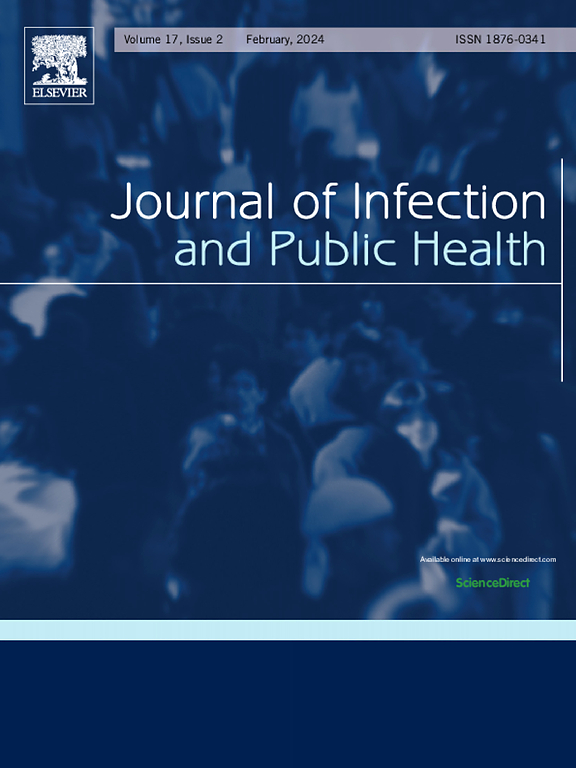Epidemiology of invasive fungal diseases in patients with hematological malignancies and haematopoietic cell transplantation recipients: Systematic review and meta-analysis of trends over time
IF 4
3区 医学
Q1 INFECTIOUS DISEASES
引用次数: 0
Abstract
Background
Invasive fungal diseases (IFD) are severe complications in patients with hematological malignancies, worsening prognosis, and increasing mortality. Despite extensive research, epidemiological data often lack temporal systematization, hindering interpretation and practical application. The objective was to assess the incidence and etiology of IFDs in oncohematological patients across different therapeutic groups using published studies.
Methods
A systematic search was conducted in PubMed (Medline), Embase, and Google Scholar. Meta-analyses using primarily random-effects models were performed to estimate IFD incidence, overall etiological structure (proportions of major genera like Aspergillus, Candida, and rare pathogens), and analyze temporal trends (pre- vs. post-2010).
Results
Incidence analysis included 34 publications (47 cohorts; 91,151 participants); etiology analysis included 35 cohorts (4427 isolates). Pooled IFD incidence was significantly higher in allo-HSCT recipients (9.96 %, 95 % CI 8.24–11.83 %) compared to chemotherapy (5.22 %, 95 % CI 3.96–6.65 %) and auto-HSCT (3.39 %, 95 % CI 1.56–5.83 %). Overall, Aspergillus (44.8 %) and Candida (34.1 %) dominated IFD etiology. A numerical shift occurred over time, with Candida proportion (48.6 %) surpassing Aspergillus (38.0 %) after 2010, reversing the pattern seen before 2010 (Candida 30.0 %, Aspergillus 47.8 %). Rare pathogens collectively accounted for ∼12.9 % pre-2010 and ∼8.8 % post-2010. Despite these numerical shifts, no statistically significant overall differences in IFD incidence or the proportions of major/rare pathogen groups were found between the pre- and post-2010 periods based on subgroup difference tests (p > 0.05). Etiology varied significantly by treatment.
Conclusion
This comprehensive meta-analysis reveals significant variability in IFD incidence and etiology based on treatment modality, with allo-HSCT conferring the highest risk. While numerical shifts in pathogen distribution occurred over time, statistically significant overall temporal trends were not detected in this dataset for major or rare pathogens. High study heterogeneity is a key limitation. The findings underscore the need for risk-stratified prophylaxis and diagnostics, informing antifungal stewardship strategies tailored to treatment settings.
恶性血液病患者和造血细胞移植患者侵袭性真菌疾病的流行病学:长期趋势的系统回顾和荟萃分析
背景:侵袭性真菌病(IFD)是血液学恶性肿瘤患者的严重并发症,预后恶化,死亡率增加。尽管进行了广泛的研究,但流行病学数据往往缺乏时间系统性,妨碍了解释和实际应用。目的是利用已发表的研究,评估不同治疗组血液肿瘤患者ifd的发生率和病因。方法系统检索PubMed (Medline)、Embase、谷歌Scholar。使用主要随机效应模型进行meta分析,以估计IFD的发病率、总体病因结构(曲霉、念珠菌和罕见病原体等主要属的比例),并分析时间趋势(2010年前后)。结果发生率分析纳入34篇出版物(47个队列;91151名参与者);病因学分析包括35个队列(4427株)。汇集IFD发病率明显高于allo-HSCT接受者(9.96 %、95 %可信区间8.24 - -11.83 %)比化疗(5.22 %、95 %可信区间3.96 - -6.65 %)和auto-HSCT(3.39 %、95 %可信区间1.56 - -5.83 %)。总体而言,曲霉(44.8% %)和念珠菌(34.1% %)是IFD的主要病因。随着时间的推移,数值发生了变化,念珠菌的比例(48.6 %)在2010年后超过曲霉(38.0 %),扭转了2010年之前的模式(念珠菌30.0 %,曲霉47.8 %)。2010年前和2010年后,罕见病原体合计占到~ 12.9 %和~ 8.8 %。尽管有这些数值上的变化,但根据亚组差异检验,2010年前后的IFD发病率或主要/罕见病原体组的比例没有统计学上的显著差异(p >; 0.05)。不同治疗的病因有显著差异。结论:这项综合荟萃分析揭示了基于治疗方式的IFD发病率和病因存在显著差异,异源造血干细胞移植的风险最高。虽然随着时间的推移,病原体分布的数值发生了变化,但在该数据集中,没有发现主要或罕见病原体的统计上显著的总体时间趋势。高异质性研究是一个关键的限制。研究结果强调了风险分层预防和诊断的必要性,为针对治疗环境量身定制的抗真菌管理策略提供信息。
本文章由计算机程序翻译,如有差异,请以英文原文为准。
求助全文
约1分钟内获得全文
求助全文
来源期刊

Journal of Infection and Public Health
PUBLIC, ENVIRONMENTAL & OCCUPATIONAL HEALTH -INFECTIOUS DISEASES
CiteScore
13.10
自引率
1.50%
发文量
203
审稿时长
96 days
期刊介绍:
The Journal of Infection and Public Health, first official journal of the Saudi Arabian Ministry of National Guard Health Affairs, King Saud Bin Abdulaziz University for Health Sciences and the Saudi Association for Public Health, aims to be the foremost scientific, peer-reviewed journal encompassing infection prevention and control, microbiology, infectious diseases, public health and the application of healthcare epidemiology to the evaluation of health outcomes. The point of view of the journal is that infection and public health are closely intertwined and that advances in one area will have positive consequences on the other.
The journal will be useful to all health professionals who are partners in the management of patients with communicable diseases, keeping them up to date. The journal is proud to have an international and diverse editorial board that will assist and facilitate the publication of articles that reflect a global view on infection control and public health, as well as emphasizing our focus on supporting the needs of public health practitioners.
It is our aim to improve healthcare by reducing risk of infection and related adverse outcomes by critical review, selection, and dissemination of new and relevant information in the field of infection control, public health and infectious diseases in all healthcare settings and the community.
 求助内容:
求助内容: 应助结果提醒方式:
应助结果提醒方式:


